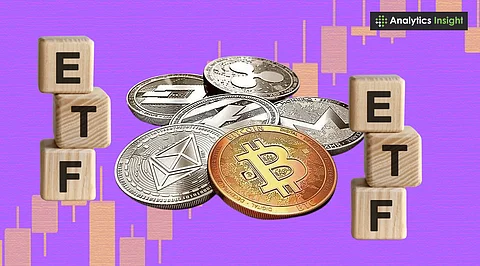

Crypto ETFs simplify digital investing by avoiding wallets, exchanges, and storage risks.
Spot ETFs hold real coins in secure cold storage while futures ETFs rely on contracts.
Investors face fees, limited access, and crypto volatility despite ETF convenience.
Cryptocurrencies such as Bitcoin and Ethereum are often seen as the future of money and investment. Over the years, they have moved from being a niche interest to something many people discuss daily.
Everyone isn’t comfortable buying digital coins directly. Setting up wallets, remembering passwords, and worrying about scams or hacks can make the process intimidating. To solve this problem, financial markets have introduced a product called a crypto exchange-traded fund or crypto ETF.
An ETF is a fund that can be bought and sold on the stock market like shares of a company. Instead of investing in just one stock, ETFs usually track the performance of something else. It could be an index, a commodity such as gold, or in this case, a cryptocurrency. A crypto ETF allows investors to benefit from the rise and fall in the price of digital coins without directly owning them.
There are two principal forms of crypto ETFs. The first is referred to as a spot ETF. This fund holds the cryptocurrency itself, i.e., Bitcoin. The second is a futures ETF, which does not own the coins themselves but rather invests in the contracts that attempt to forecast the future value of the cryptocurrency.
The first Bitcoin futures ETF was launched in the US in 2021. For many years, regulators did not allow spot ETFs because they feared fraud and manipulation. In 2024, the US Securities and Exchange Commission approved spot Bitcoin ETFs from big companies like BlackRock and Fidelity. A few months later, Ethereum also got spot ETFs. This was a big step that brought cryptocurrencies into mainstream finance.
Also Read: ETFs: A Smart Way to Invest in Crypto for the Long Run
A crypto ETF’s price stays close to the price of the cryptocurrency it follows. This is managed by big institutions called authorized participants. When more people want ETF shares, these institutions put money into the fund to buy the asset or contracts and create new shares. When fewer people want ETF shares, some shares are taken out of the market.
Spot ETFs hold real cryptocurrency, usually kept in cold storage wallets that stay offline and are harder for hackers to reach. This gives investors confidence because the responsibility of storing the crypto safely is handled by experts.
Crypto ETFs are appealing as they simplify investing in cryptocurrencies. Rather than establishing a crypto wallet or registering for a crypto exchange, investors can just invest in the ETF shares from the stock market, the same way they invest in Apple or Reliance shares.
ETFs also bring regulation and security. They follow strict rules and share regular updates with investors. This makes them seem more trustworthy to people who worry about the risks of the crypto market.
Another benefit is liquidity. ETFs can be traded anytime during market hours, making it easy to buy or sell. Some funds also include many cryptocurrencies, which spreads the risk across different digital assets.
There are also some downsides. Crypto ETFs charge a management fee, which reduces profits over time. Investors also do not own the cryptocurrency. This means they cannot transfer it, spend it, or use it in any other way.
Another concern is that the ETF trades only during stock market hours, whereas the cryptocurrency markets are available for trading all day and all year round. If something significant occurs overnight, the price of the ETF won't reflect it until the stock market opens. There can also be tiny discrepancies between the ETF price and the true cryptocurrency price, referred to as tracking error.
And of course, the largest risk is from the cryptocurrencies themselves. Bitcoin and Ethereum may zoom upwards, but also crash unexpectedly. On top of all this, shifting regulations across various nations continue to cast a shadow of uncertainty.
Crypto ETFs paved the way for a large number of individuals to join the digital asset market securely and familiarly. They connect the world of cryptocurrencies with traditional finance. For investors, they eliminate the technical obstacle of dealing with digital coins, yet retain the opportunity to profit from price movements. Simultaneously, they impose costs, limitations, and risks that need to be comprehended clearly.
Crypto ETFs may not replace owning cryptocurrency directly, but they are already becoming an important part of how digital assets fit into the financial system.
